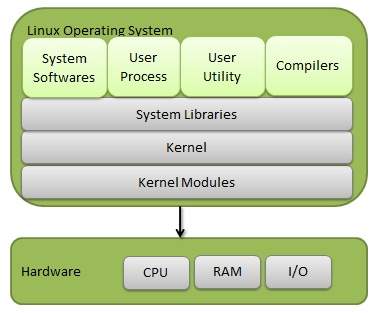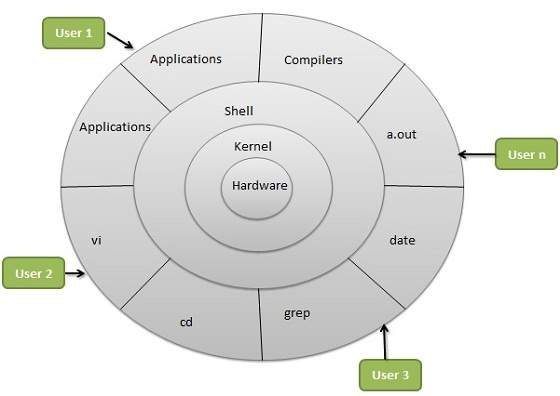- Operating System — Linux
- Components of Linux System
- Kernel Mode vs User Mode
- Basic Features
- Architecture
- Features of Linux Operating System
- What are the Features of Linux Operating Systems?
- 1. Free and Open-Source
- 2. Extremely Flexible
- 3. Lightweight Infrastructure
- 4. Graphical User Interface (GUI)
- 5. End-to-end encryption
- 6. Portable Environment
- 7. Shell/ Command-line Interface
- 8. Customized keyboard
- 9. Frequent New Updates
- 10. Hierarchical File System
- 11. Multi-user and Multi-programming
- Conclusion
Operating System — Linux
Linux is one of popular version of UNIX operating System. It is open source as its source code is freely available. It is free to use. Linux was designed considering UNIX compatibility. Its functionality list is quite similar to that of UNIX.
Components of Linux System
Linux Operating System has primarily three components
- Kernel − Kernel is the core part of Linux. It is responsible for all major activities of this operating system. It consists of various modules and it interacts directly with the underlying hardware. Kernel provides the required abstraction to hide low level hardware details to system or application programs.
- System Library − System libraries are special functions or programs using which application programs or system utilities accesses Kernel’s features. These libraries implement most of the functionalities of the operating system and do not requires kernel module’s code access rights.
- System Utility − System Utility programs are responsible to do specialized, individual level tasks.
Kernel Mode vs User Mode
Kernel component code executes in a special privileged mode called kernel mode with full access to all resources of the computer. This code represents a single process, executes in single address space and do not require any context switch and hence is very efficient and fast. Kernel runs each processes and provides system services to processes, provides protected access to hardware to processes.
Support code which is not required to run in kernel mode is in System Library. User programs and other system programs works in User Mode which has no access to system hardware and kernel code. User programs/ utilities use System libraries to access Kernel functions to get system’s low level tasks.
Basic Features
Following are some of the important features of Linux Operating System.
- Portable − Portability means software can works on different types of hardware in same way. Linux kernel and application programs supports their installation on any kind of hardware platform.
- Open Source − Linux source code is freely available and it is community based development project. Multiple teams work in collaboration to enhance the capability of Linux operating system and it is continuously evolving.
- Multi-User − Linux is a multiuser system means multiple users can access system resources like memory/ ram/ application programs at same time.
- Multiprogramming − Linux is a multiprogramming system means multiple applications can run at same time.
- Hierarchical File System − Linux provides a standard file structure in which system files/ user files are arranged.
- Shell − Linux provides a special interpreter program which can be used to execute commands of the operating system. It can be used to do various types of operations, call application programs. etc.
- Security − Linux provides user security using authentication features like password protection/ controlled access to specific files/ encryption of data.
Architecture
The following illustration shows the architecture of a Linux system −
The architecture of a Linux System consists of the following layers −
- Hardware layer − Hardware consists of all peripheral devices (RAM/ HDD/ CPU etc).
- Kernel − It is the core component of Operating System, interacts directly with hardware, provides low level services to upper layer components.
- Shell − An interface to kernel, hiding complexity of kernel’s functions from users. The shell takes commands from the user and executes kernel’s functions.
- Utilities − Utility programs that provide the user most of the functionalities of an operating systems.
Features of Linux Operating System
LINUX is an open-source operating system used extensively worldwide. It is free and its source code is available for everyone under GNU(General Public Licence).
Linux as an Operating System provides a wide range of features that can be used by a wide range of systems such as servers and computers.
Android OS is also based on the Linux kernel that extends its usage for building embedded systems and automation systems.
What are the Features of Linux Operating Systems?
The following are the features of the Linux Operating system:
1. Free and Open-Source
Linux is completely free of cost, and expenses are never a hindrance to using it as an operating system.
Linux is open-source. This means that modification of code, analysis of codes, redistribution of codes, or selling copies of the enhanced codes can be done by anyone in the world provided they come under the same license where the license also costs no charge.
Linux operating system is released under the GNU(General Public Licence) and is now one of the largest open-source projects worldwide.
2. Extremely Flexible
Linux has incorporated itself into embedded products like watches, digital equipment and supercomputing servers.
There are no prerequisites for installing an entire Linux suit. It allows a user to install only the components that are required by the user.
3. Lightweight Infrastructure
Linux consumes lesser storage space, and its installation requires around 4GB to 8GB of disk space.
Memory footprint or the amount of memory (RAM) used by the software while running is also less and it is compatible with all kinds of file formats like text files, audio files, video files, graphic formats, etc.
4. Graphical User Interface (GUI)
Even though Linux works on using the command line interface but it can be converted to be used like windows having a Graphical user interface. This is done mostly by installing packages. The most common way of having a GUI on the Linux environment is to log in to Ubuntu server and install its desktop environment.
5. End-to-end encryption
Linux allows end-to-end encryption while accessing data thus storing public keys in the server. All data is password protected and provides authentication to users. It also allows many security features and provides file permissions, a secure shell, etc.
6. Portable Environment
Linux works on any kind of environment and doesn’t depend on the device being high-ended or low-ended. A large number of users can simultaneously use it anytime, any place, and on multiple devices. It supports all kinds of hardware to work on.
Multiple distributions or enterprises are also supported by Linux.
Linux has its own repository for software that can be used to install the required packages.
7. Shell/ Command-line Interface
The Linux command line interpreter is known as Shell that provides an interface between the user and kernel which then executes programs known as commands.
Hence, Linux uses Command-line interface to carry out the execution of tasks which is comparatively more efficient to execute and takes lesser time. It also takes lesser space in the memory,
8. Customized keyboard
Linux is available in all languages which makes it acceptable worldwide. That is why language can be changed from the keyboard according to the requirements and preferences.
Users can also build their own customized layout for keyboards.
9. Frequent New Updates
Linux operating system provides a wide range of accessible software updates that can be deployed and used according to requirements.
They update more frequently thus giving users an option to choose the updates and install them as per their need.
10. Hierarchical File System
Linux comes with a well-defined file structure where user files are arranged in a definite directory structure. According to the type of files, the directories are categorised as Binary directories, configuration directories, Data directories, memory directories, Usr(Unix System Resources), var(variable directory) and non standard directories.
11. Multi-user and Multi-programming
Linux allows multiple users to access the system resources at the same time and allows multiple applications to run at the same time.
Conclusion
- Linux is one of the best and most widely operating systems that support all kinds of programming languages.
- Multiple functions can be performed at a time.
- Linux supports multithreading and high-volume applications to be used for a system.
- As discussed above, the Linux operating system is free and open-sourced, facilitates a customized keyboard, has a command line interface but also supports GUI on Linux environment and gives easy access to newer updates frequently.
- It is secure and end-to-end encrypted which leads to user authentication while working.
- In a nutshell, Linux operating system is portable, easy to use and the most flexible operating system.



